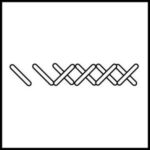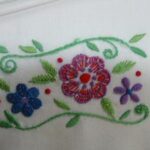Minky fleece is a very popular fabric right now. There are so many varieties of minky – dots, paisley, stripes, chenille, and several others. Paired with another fabric or a coordinating minky, items made with this fabric are cuddly, soft, and warm. Unfortunately, this fabric has some stretch to it, and that can scare many sewers away, especially those that are new to sewing. Minky is not hard to sew with, but it does take some getting used to.
Before you attempt to create any piece with any type of fabric, you need to make sure that your stitch length and tension are on track. Practice on a scrap piece first. This is the first thing you learn when you start sewing. If you don’t know how to adjust the tension, don’t mess with it! You don’t want to have to pay someone to recalibrate the machine, unless it’s time to be serviced anyway. When sewing with minky, I have found that the smaller stitches tend to be harder to use. It is harder to get the tension correct with them. However, when I use a longer stitch length and keep the tension set on 4 on my Janome sewing machine, I don’t have any problems. Both straight stitch and zigzag have worked equally well. I also have always used a regular presser foot. The feed dogs on the bottom combined with a regular presser foot seem to do the trick. I do like to sew minky side down though.
Minky is a fleece, and as such, should not be ironed because it will melt, but it is a good idea to wash the fabric before you sew with it. If you are going to pair minky with another fabric, such as a cotton, be absolutely sure to wash that other fabric. Minky generally doesn’t shrink, but cotton will. If you do not do this, your creation may end up lopsided, sloppy, and seem like a waste of time. This isn’t always the case, but why take the chance of your other fabric shrinking?
Whether you use two minky fleece pieces together or combine minky with another fabric, especially one like satin or silk, be sure to pin, pin, pin. You could also baste it by hand if you are afraid of it really not keeping together. I have never done this though, neither have I taped it. I have found the best success when pinning about every 3/4 to an inch apart. This seems to really keep the fabric in the position that I want it. Pinning is even more imperative when sewing a piece of minky to another piece of minky because you are sewing two stretchy pieces of fabric together, which increases your chances of having it stretch when it shouldn’t or the two fabrics not matching completely up. Try to keep your seams as straight as possible and the minky will look fabulous after you turn it right-side out and top stitch. If your seams are a little crooked, try topping it with some ribbon to help even the look out around the edges.
The other thing that is good to keep in mind about sewing with minky is that it is very fuzzy, so be prepared to clean yourself and your workspace often. Fuzz flies everywhere once it is cut, even when using pinking shears! It’s a good idea to shake your creation off or wash it as soon as possible to cut down on the fuzz factor when you take it to other parts of the house. Also be sure to check your machine to make sure it’s not clogging up machine parts (which sewing with any fabric can eventually do, but fuzzy fabrics seem to hasten the need to clean.)
Have fun sewing with this fabulous fabric!




